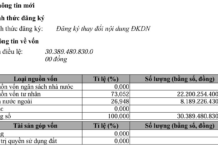
The Ho Chi Minh City Belt Road 4 project, highlighted in yellow, spans 207 km across five provinces and cities in the Southeast region, with a total expected investment of nearly VND 106,000 billion.
|
According to the Ministry of Transport, the construction project of Ho Chi Minh City Belt Road 4 is listed as one of the important national projects and a key focus of the transport industry.
The investment plan for this project has been studied and proposed by relevant ministries, sectors, and local authorities. The Prime Minister has decided to assign the local authorities as the competent agencies for implementing the five project components of the Ho Chi Minh City Belt Road 4, corresponding to the five localities: Ho Chi Minh City, Ba Ria-Vung Tau, Dong Nai, Binh Duong, and Long An. Ho Chi Minh City has been designated as the focal point for coordinating the implementation of these components, while the Ministry of Transport will perform the function of state management and organize the coordination of deployment along the entire route.
So far, the localities have organized and basically completed the pre-feasibility study reports for the project components. Specifically, the Thu Bien Bridge – Saigon River section has been approved by the Binh Duong Provincial People’s Council for investment in the form of a public-private partnership (PPP), and the investment approval is expected in September 2024.
According to the report of the Ho Chi Minh City People’s Committee in Document No. 5100/UBND-DA dated August 31, 2024, the leaders of the Ministry of Planning and Investment held a meeting with the leaders of the Ho Chi Minh City People’s Committee and the leaders of the People’s Committees of the related provinces (Ba Ria-Vung Tau, Dong Nai, Binh Duong, and Long An) to discuss the implementation progress and identify difficulties and obstacles during the process. These obstacles include the large investment scale of the project (a total length of 207 km and a preliminary total investment of about VND 128,063 billion), requiring a significant amount of state capital, while the local budgets are facing difficulties in balancing and allocating funds. To address this, the leaders of the Ministry of Planning and Investment and the People’s Committees of the provinces and cities agreed on several contents to accelerate the project’s progress.
Based on the meeting’s results, the Ho Chi Minh City People’s Committee reported and proposed three recommendations to the Prime Minister: Approve the direction to establish a pre-feasibility study report for the overall project and research and propose special mechanisms and policies for the project; Assign the Ho Chi Minh City People’s Committee to take the lead in completing the project’s pre-feasibility study report and submit it to the competent authority for appraisal and approval (submit it to the National Assembly during the October 2024 session); Assign the Ministry of Planning and Investment to take the lead in organizing the appraisal and advising the Prime Minister on balancing and allocating the central budget capital for the project, reporting to the competent authority for consideration and decision.
Proposal to merge into a comprehensive project
The Ho Chi Minh City Belt Road 4 is of great importance to the socio-economic development of the key economic region in the South and has a significant inter-regional connectivity role. According to the Master Plan, the Ho Chi Minh City Belt Road 4 is scheduled for completion before 2030.
Resolution No. 24-NQ/TW dated October 7, 2022, of the Politburo set the goal of completing the Ho Chi Minh City Belt Road 4 by 2030. In Document No. 1263/TTg-CN dated September 29, 2021, the Prime Minister assigned the local authorities as the competent agencies for organizing the implementation of the project components. However, there are still challenges and obstacles in the implementation process that need to be addressed.
The Ministry of Transport agrees to research deployment options to select the optimal solution and promptly propose solutions to overcome difficulties and obstacles, promoting the project’s progress.
Regarding the deployment and implementation plan, the Ministry of Transport proposed combining the five project components across five localities into one comprehensive project for appraisal and approval of the investment policy. This proposal differs from the implementation plan directed by the Prime Minister in Document No. 1263/TTg-CN dated September 29, 2021. Therefore, it is recommended that the Ministry of Planning and Investment coordinate with the Ho Chi Minh City People’s Committee and related localities to provide additional information on the advantages and feasibility of implementing the project to report to the Prime Minister for consideration and decision.
With the proposal to combine into one comprehensive project, assigning the Ho Chi Minh City People’s Committee to take the lead in completing the pre-feasibility study report is appropriate. This is similar to the task of being the focal point for coordinating the implementation of the project components, as assigned by the Prime Minister in Document No. 6032/VPCP-CN dated August 7, 2023, of the Government Office. It is also consistent with the organization of the pre-feasibility study report preparation for investment projects of the Hanoi Belt Road 4 and Ho Chi Minh City Belt Road 3.
Regarding the progress of submitting the investment policy, the Ministry of Transport agrees on the need to accelerate the project progress, aiming to submit it to the National Assembly for a decision on the investment policy during the October 2024 session. To achieve this, the Ho Chi Minh City People’s Committee and the People’s Committees of Ba Ria-Vung Tau, Dong Nai, Binh Duong, and Long An provinces need to concentrate their resources to meet this deadline.
At the same time, the Ministry of Transport proposed that the Ministry of Planning and Investment coordinate with the Ho Chi Minh City People’s Committee and related localities to review and rebuild the implementation plan. They should refer to the actual progress of project implementation in the past and the time required for the appraisal procedure as stipulated in Clause 1, Article 21 of the Law on Public Investment to ensure the accuracy of the progress report to the Prime Minister, guaranteeing feasibility and practicality.
Regarding the organization of the pre-feasibility study report appraisal, in Document No. 5100/UBND-DA dated August 31, 2024, the Ho Chi Minh City People’s Committee proposed that the Ministry of Planning and Investment take the lead in advising and organizing the appraisal of the project’s pre-feasibility study report. However, the proposed deployment plan is to combine the five components into one comprehensive project (a project of national importance), which is inconsistent with the regulations stipulated in Article 19 of the Law on Public Investment. In this case, it is recommended that the Ministry of Planning and Investment report to the Prime Minister to establish a State Appraisal Council, chaired by the Minister of Planning and Investment, to appraise the pre-feasibility study report according to regulations.
Regarding the arrangement of central budget capital, the Ministry of Transport stated that this project has a considerable investment cost (a preliminary total investment of about VND 128,063 billion). Therefore, combining the central budget with local budgets is necessary for implementing the project, especially considering the financial difficulties of some localities where the project passes through.
“The Ministry of Transport agrees to propose that the Ministry of Planning and Investment report to the Prime Minister to balance and allocate the central budget capital for the project with a suitable ratio and the ability to balance resources, reporting to the Standing Committee of the National Assembly for registration and reporting to the National Assembly at the October 2024 session,” the Ministry of Transport stated.
Unlocking Opportunities: The Path to Success in the EU Market
The upcoming visit from Slovenia’s transport and logistics experts offers a strategic opportunity for Vietnamese businesses to strengthen their presence in Southern and Central Europe. This delegation visit opens doors for local enterprises to explore new avenues of collaboration, particularly in terms of accessing fresh routes for the efficient transportation of goods into the heart of the EU market.
The Future of Transportation: Revolutionizing Travel with the 350 km/h High-Speed Rail, Aiming for Construction to Commence Before 2030.
“The Deputy Prime Minister, Mr. Tran Hong Ha, has emphasized the need to prioritize the development of high-speed and urban railways as a strategic move to boost Vietnam’s mechanical, manufacturing, automation, and other industries. He envisions a thriving railway system that will act as a catalyst for economic growth and enhance the lives of its citizens.”











































